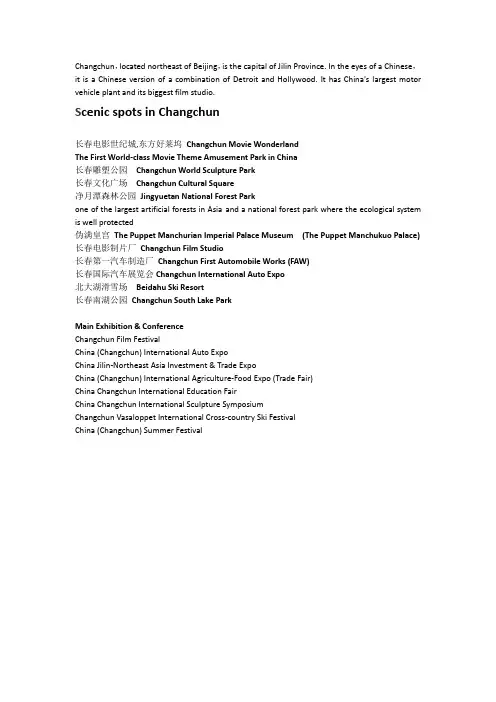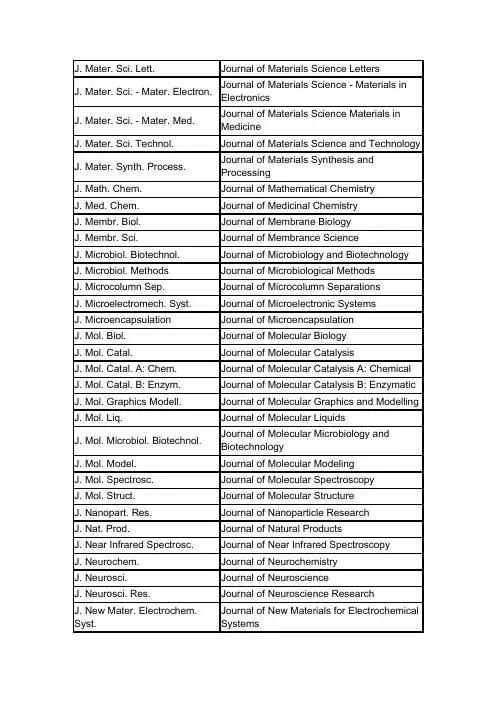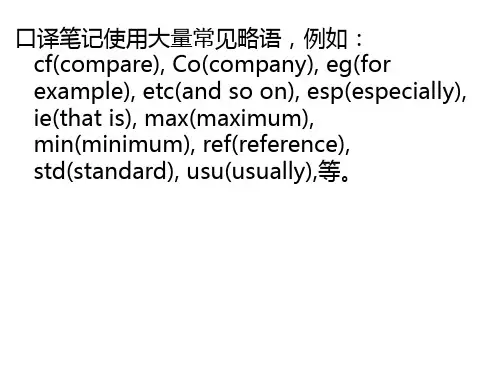MAIN SYMPOSIUM
- 格式:pdf
- 大小:378.63 KB
- 文档页数:67


《计算机组成与设计》典型思政案例山东大学计算机科学与技术学院《计算机组成与设计》课程团队知识点思政元素计算机的基本组成/计算机发展史山东大学DJL 1集成电路数字通用计算机➢1972年山东大学自主研制成功DJL-1小规模集成电路计算机获全国科学大会奖➢作为新一代山大人为中国计算机发展做出贡献科技报国图片来源于网络,仅用于教学图片来源于网络,仅用于教学知识点思政元素指令集设计龙芯推出自主研发指令集➢当今国际形势下,指令集对芯片的自主研发起到关键性作用➢龙芯推出自主研发指令集LoongArch ,支撑“中国芯”提升行业服务意识科技报国图片来源于网络,仅用于教学知识点思政元素指令流水火神山的“中国速度”➢流水线的思想是火神山速度的支撑➢科技支撑“中国速度”,专业素质支撑科技发展提升行业服务意识2020年1月23日,武汉市委市政府做出建设“火神山”医院的决定2月2日,火神山医院完成交接10天!图片来源于网络,仅用于教学冯·诺依曼架构的性能瓶颈存储器运算器计算机的基本组成/冯·诺依曼体系架构华人学者对计算机架构的前沿研究存内计算架构存储器运算阵列Chi, Ping, et al.. “PRIME: A Novel Processing -in-Memory Architecture for Neural Network Computation in ReRAM-Based Main Memory.”In 2016 ACM/IEEE 43rd Annual International Symposium on Computer Architecture (ISCA).➢基于经典的冯·诺依曼架构,大数据应用中存储器和运算器间有大量数据交换,成为性能瓶颈➢2016年加利福尼亚大学圣塔芭芭拉分校华人教授团队提出“存内计算”这种新架构,有效解决了这一问题了解前沿知识、开拓眼界的同时培养文化自信计算机的工作步骤/计算机的工作步骤计算机国际形势图片来源于网络,仅用于教学➢复杂的国际形势下需要掌握核心技术➢了解计算机工作方式是设计计算机的重要基础夯实基础,科技报国图片来源于网络,仅用于教学知识点思政元素存储介质/DRAM DRAM 国际市场形势➢DRAM 是当今计算机系统内存的主要介质➢目前DRAM 的国际市场,韩国三星、海力士、美国美光占97%的市场份额,处于垄断地位➢关注国际、国内DRAM 行业发展,贡献自己力量提升行业服务意识44%29%24%3%DRAM 国际市场份额三星SK 海力士美光其他知识点思政元素存储器访问/并行访问效率中国银河-1号巨型计算机➢我国研发的银河-I巨型计算机的存储器结构:素数模块、交叉访问,分析其并行性➢1983年研制成功,填补了国内巨型计算机的空白,中国成为继美国、日本之后,第三个能独立设计和制造巨型计算机的国家树立实现中华民族伟大复兴的信心银河-1号巨型计算机图片来源于网络,仅用于教学图片来源于网络,仅用于教学知识点思政元素存储器扩展国产内存模块上市➢2020年,合肥长鑫自主研发内存模块上市,填补国产DRAM 空白➢该内存模块由8个内存颗粒扩展而成,结合本节知识分析其扩展方式树立文化自信,科技报国自主研发的国产长鑫DDR4内存模块知识点思政元素存储器校验/海明校验海明发明校验方法的故事Richard Hamming(1915-1998)图片来源于网络,仅用于教学➢海明为了解决读卡错误,提出改进的校验方法➢鼓励学生养成善于发现问题、解决问题的习惯勤于观察,擅于创新图片来源于网络,仅用于教学知识点思政元素存储器/cache中国互联网的蓬勃发展➢2020年互联网普及率达70.4%,极大便利了人们生活➢PowerCache(缓存)技术是打破网络速度瓶颈的武器培养文化自信网络扶贫:累计帮助超过100万贫困人口脱贫,宽带网络覆盖90%以上的贫困村网络教育互联网医疗电商直播图片来源于网络,仅用于教学知识点思政元素原码中国数学家首次提出正负数概念➢负数是由三国时期中国数学家刘徽在《九章算术》提出的➢为数的表示提供了科学的方法“正算赤,负算黑;否则以斜正为异”---三国∙刘徽培养民族自豪感视频来源于网络,仅用于教学知识点思政元素溢出阿丽亚娜-5空难➢1996年6月4日,阿丽亚娜-5运载火箭首次测试发射,火箭在发射后37秒被迫自行引爆。

Changchun,located northeast of Beijing,is the capital of Jilin Province. In the eyes of a Chinese,it is a Chinese version of a combination of Detroit and Hollywood. It has China's largest motor vehicle plant and its biggest film studio.S cenic spots in Changchun长春电影世纪城,东方好莱坞Changchun Movie WonderlandThe First World-class Movie Theme Amusement Park in China长春雕塑公园Changchun World Sculpture Park长春文化广场Changchun Cultural Square净月潭森林公园Jingyuetan National Forest Parkone of the largest artificial forests in Asiaand a national forest park where the ecological system is well protected伪满皇宫The Puppet Manchurian Imperial Palace Museum (The Puppet Manchukuo Palace) 长春电影制片厂Changchun Film Studio长春第一汽车制造厂Changchun First Automobile Works (FAW)长春国际汽车展览会Changchun International Auto Expo北大湖滑雪场Beidahu Ski Resort长春南湖公园Changchun South Lake ParkMain Exhibition & ConferenceChangchun Film FestivalChina (Changchun) International Auto ExpoChina Jilin-Northeast Asia Investment & Trade ExpoChina (Changchun) International Agriculture-Food Expo (Trade Fair)China Changchun International Education FairChina Changchun International Sculpture SymposiumChangchun Vasaloppet International Cross-country Ski FestivalChina (Changchun) Summer Festival。

制片人, 监制Producer副制片人Junior Producer出品人Executive Producer总策划Associate producer策划Co-Associate producer执行制片人Line producer执行制片人Executive Producer制片人Co-Executive Producer广播制作人Broadcast Producer制作公司production house制片PA Production电视制片人Television Producer电视制片工程师Television Production Engineer执行导演First assistant director Co-Script editor总编Chief Editor高级编辑Senior Editor编辑助理,一般编导Assistant Editor执行编辑Managing Editor制作编辑Production Editor助理编辑Associate Editor总监制Production Supervisor监制Co- Production Supervisor技术监制Technical supervisor特效指导effects supervisor活动策划Events Planner编剧Screenwriter编审Script editor Coordinator摄影Photographer Production designer录音Sound Composer动画3D-animation制作组production crew导演Director /action director编辑主任Editorial Director摄影指导director of photography节目部主任Program Director电视导演Television Director广播节目总监Radio Program Director主要赞助商main sponsor联合赞助商co-sponsor领衔主演starring特别演出special appearance联合演出co-starring电台播音员Radio Announcer摄影助理camera assistant灯光师gaffer灯光助理lighting grip收音sound mixer特技指导stunt choreography剧照movie stills信息专员Information Support Specialist 公共关系Public Relations公共关系助理Public Relations Assistant研讨会协调员Symposium Coordinator 节目协调人Program Coordinator新闻记者Journalist校对Proofreader翻译员Translator排字工人Typesetter广告员Publicist记者Reporter专栏作家Columnist文件编辑Copy Editor通讯记者Correspondent作家Author作者Writer。







研究生英语学位课考试(词汇与练习)GET研究生英语学位课考试丛书研究生英语学位课考试词汇与练习词汇练习1:1.Because of the harsh punishment, these prisoners of war ______ their attempt to escape.A. abandonedB. desertedC. discardedD. quit2.More reforms will be introduced to ______ economic development in this ancient country.A. illustrateB. illuminateC. liberateD. accelerate3.There is no ______ authority in scientific studies, each having his own advantages.A. absoluteB. abstractC. abruptD. abundant4.High school students in China are judged mainly in terms of ______ performance.A. accurateB. adequateC. academicD. accidental5.This old building is to be ______ by a special team to make room for a modern one.A. abolishedB. polishedC. accomplishedD. demolished6.Many women took to the street to join the demonstration to make ______ legal.A. adaptationB. adoptionC. abortionD. addiction7.In the 1970s meat used to be difficult to ______ in China.A. abide byB. pass byC. go byD. come by8.In this photo the woman mayor is talking to a passenger ______ a bus.A. abroadB. aboardC. broadD. board9.Anyone with the Internet ______ can find out about these universities easily.A. excessB. accessC. processD. entrance10.Nothing can be more ______ than to say that humanbeings are doomed.A. abnormalB. ambiguousC. ambitiousD. absurd11.There is something unusual ______ this girl: she seldom smiles.A. aboutB. withC. forD. in12.To ______ one’s power is to commit a crime and eventually end up in jail.A. accuseB. abuseC. deduceD. excuse13.The school is going to take disciplinary ______ against those who smoke at school.A. stepsB. measuresC. actionD. pace14.The process of language ______ has been a mystery to linguists and psychologists.A. innovationB. acquisitionC. administrationD. institution15.Thanks to good service and _______, the tourists left thehotel pleased and satisfied.A. accommodationsB. allegationsC. attachmentsD. anticipations16.It is important that teachers of elementary schools ______ themselves with habits of childrenA. accustomB. acquaintC. accompanyD. accumulate17.A number of hypotheses have been raised to ______ the extinction of dinosaursA. answer forB. account forC. ask forD. act for18.Thanks to medical advances, the ______ of some deadly diseases has drastically declined.A. accidentB. incidenceC. incidentD. accent19.The word SARS is an abbreviation of the severe ______ respiratory syndrome.A. advancedB. actualC. adverseD. acute20.One of the most important periods for human growth is______.A. indulgenceB. adolescenceC. conscienceD. consciousness21.It is very selfish to take ______ of this disaster for personal gains.A. aggressionB. affectionC. adventureD. advantage22.These people have conquered numerous difficulties by ______their beliefs and values.A. adjusting toB. adhering toC. adapting toD. adding to23.To ensure the ______ supply of vegetables to cities calls for easy transportation.A. adequateB. addictiveC. approximateD. antique24.A doctor determines the dose of medicine to be ______ according to the patient’s condition.A. advocatedB. administeredC. addressedD. amplified25.Improved teaching facilities have made easier ______ tocollege in China.A. admirationB. advertisementC. admissionD. allowance26.As an aged and weak man, Brown walked with ______ steps while enjoying the sun.A. authenticB. automaticC. auxiliaryD. awkward27.In 1771, these colonies won ______ and became one country under George Washington.A. astronomyB. monopolyC. autonomyD. harmony28.The strong interest in flying led the boy to study ______ at college.A. auctionB. aviationC. auditionD. aesthetics29.Her determination to ______ her goal of life motivated her to greater effort.A. retainB. attainC. maintainD. entertain30.International students rarely meet with ______ in thishighly democratic country.A. attemptB. contemptC. temptationD. tempern students are likely to show ______ in mathematics when studying in the U.S..A. superiorityB. availabilityC. accessibilityD. authenticity32.Games such as badminton and basketball often take place inside a(n) ______.A. auditoriumB. gymnasiumC. stadiumD. symposium33.The professor was surprised at the full ______ and began his lecture with enthusiasm.A. audienceB. attendanceC. presenceD. appearance34.The main point is that a lot of network power, being concentrated and hierarchical, may not have the ______ of the Internet that are distributed and open.A. assignmentsB. attributesC. associationsD. assumptions35.Words borrowed from another language can be ______ and accepted.A. assembledB. simulatedC. assaultedD. assimilated36.The couple was ______ to find their apartment broken into upon their return from the holiday.A. assuredB. astonishedC. assertedD. assessed37.Artistic design involves ______ and accumulation of a wide scope of knowledge.A. aspirationB. initiationC. inspirationD. conspiracy38.The whole nation was in deep sorrow at the ______ of their beloved president Abraham Lincoln.A. assassinationB. globalizationC. desertificationD. presumption39.The Chinese tent to look at the Japanese attitude from a historical ______.A. aspectB. perspectiveC. dimensionD. sphere40.Fixed ______ of the state cannot be transferred to individuals at random.A. artilleriesB. architecturesC. archivesD. assets41.The outlaw ______ an air of confidence in spite of his fake ID card.A. presumedB. consumedC. assumedD. resumed42.With so many matters to ______, this lady can hardly spare any moment at work.A. attribute toB. attend toC. apply toD. appeal to43.Those whose mind has failed have to be taken to a lunatic ______ for treatment.A. assemblyB. arteryC. assuranceD. asylum44. Freud became world famous for his studies in ______ following the publication of Interpretations of Dreams.A. psychologyB. archaeologyC. ecologyD. meteorology45.Applicants for this job will be given a(n) ______ test to see if they are fit.A. altitudeB. attitudeC. latitudeD. aptitude46.The farmers didn’t suffer much loss. ______, five houses were damaged.A. After allB. Above allC. For allD. In all47.An artistic housewife will try to ______ her child to make him or her look different.A. arouseB. arrestC. arrangeD. array48.The emergence of modern electrical ______ has reduced the hours spent on housework.A. applicationsB. applicantsC. appliancesD. applicability49.Being white, this West Indian has the freedom to take any job that ______ him.A. appeals toB. takes toC. caters toD. adapts to50.Any new law is subject to the ______ of the Congress and president before becoming valid.A. agreementB. approvalC. allowanceD. appraisal51.The Chinese are likely to ______ economic reform with Deng Xiaoping.A. connectB. linkC. associateD. contact52.Grand celebrations will be held to mark the 55th ______ of the founding of PRC.A. commemorationB. recollectionC. memorizationD. anniversary53.The teacher tried to ______ the bored students with jokes, but to little effect.A. amazeB. amuseC. annoyD. ascertain54.Long periods of social disturbance almost ______ anarchy.A. stands atB. takes onC. keeps downD. amounts to55.New linguistic forms can be created by means of _____, asoften happens.A. analogyB. ammunitionC. abundanceD. ambulance56.The uneven ______ of population is reflected in the different density of population.A. allocationB. promotionC. assignmentD. distribution57.Surgeons often make ______ plans for a major operation in advance.A. interactiveB. alternativeC. initiativeD. instinctive58.Towards the end of WWII, German war machines were destroyed by ______ forces.A. unitedB. integratedC. mergedD. allied59.The guest called back ______ the hospitality on the part of the host.A. in line withB. in favor of`C. in case ofD. in acknowledgementof60.He is said to be a prominent musician and poet, but actually he is ______ an ordinary amateur poet.A. anything butB. nothing besidesC. something ofD. far from61.The ______ manners of these movie stars can never impress reporters favorably.A. arbitraryB. appallingC. arrogantD. ample同义词表1:abandon: give up desert discard throw away quit get rid of ability: capability capacity gift talent aptitude faculty power able: capableabolish: put an end to do away with cancelabroad: overseasabrupt: steep sheerabruptly: suddenly all of a sudden all at onceabsence: lack shortage insufficiency deficiencyabsorb: take in assimilate be absorbed in: be concentrated on focus on be lost in put one’mind toabsurd: strange ridiculous far-fetched fantasticabundant: ample rich sufficient adequate plentifulabuse: misuseaccelerate: boost speed up quicken stimulate promoteaccess: entrance admissionaccidental: casual unexpectedacclaim: applaud hail welcomeaccommodate: adapt reconcile(使…一致或和解)accompany: couple escortin accordance with: in line with in agreement with in conformity withaccordingly: correspondinglyaccount: description narration advantageaccount for: make up constitute explain on account of: because of due to thanks to take into account: take into considerationaccurate: precise exactaccuse (of): charge (with) prosecute (for) suebe accustomed to: be used to be habituated toachieve: attain reach achievement: success accomplishment featacknowledge: admit concede confess recognize express gratitude toacquaint (with): familiarize (with)acquire: gain get come by learntake action: do something take steps take measuresadequate: proper appropriate sufficientadd up to: total come to amount toaddress: speak to cope with settle (issues)adhere to: stick to cling toadjust: regulate conditionadministration: management authority governmentadolescent: teenager juvenileadopt: take use employadvanced: up-to-date sophisticated highly developed state-of-the-art difficultin advance: beforehandadvantage: superiority take advantage of: use benefit from adventure: risk ventureadverse: unfavorable hostile negativeadvocate: preach plead supportaffect: influence effect: impactaffluent: rich well offaggression: attack assault occupationaggressive: brave bold rudeagony: anguish distress pain suffering torment agreeable: pleasantaim: purpose object objective intention*** alert: wary on guard againstalien: foreignalike: similar identicalafter all: anyway in all: altogether all toldallege: assert supposeallocate: distribute set apart designateallowance: subsidy premiumally: associate connect relatealmost: nearly as good as literally next to virtuallyalter: changealternative: choice optionaltitude: heightamaze: surprise astonish astound shock stun ambiguous: vague obscureambition: aspiration ideal wishamend: revise reformamount to: be equivalent toamplify: enlarge expandamuse: interest entertainannounce: declare proclaim make openannoy: anger irritate exasperateanswer for: be responsible for be accountable for be liable foranticipate: expectanxiety: worry concernapart from: besidesappalling: shocking horrible fearfulapparatus: instrument equipment facility appliance implement deviceappeal to: turn to resort to interestappear: emerge turn up arise come up come into beingapply: employ use utilize apply oneself to: devote oneself to appraise: assess evaluate estimate reckonappreciate: value cherish treasure express gratitude forapproach: draw near come near get close to method means approaching: coming imminentapprove: agree to endorse supportapproximately: about nearly roughlyarchives: document filearouse: awaken waken work up stir up activatearray: decoratearrival: adventarrogant: conceited proudarticulate: utter express voiceascertain: find out determineashamed: guiltyaspect: respect wayassassination: murder*** assemble: gather rally put togetherasset: property belongingsassistance: aid support helpassume: presume adopt take onassure: convince ensure guarantee insure informasylum: shelterbe attached to: like loveattempt: try seekattract: drawattractive: charming engagingauthentic: genuine real trustworthyauthority: government administrationautomobile: motoravenue: streetbe aware of: acknowledge be conscious of recognizeawkward: clumsy inflexible embarrassed应掌握的用法1:abandon a plan abide by these regulations law-abiding people(守法的人)improve one’s ability to express himself in English a man of ability abnormal behavior get aboard a ship meet a friend aboard a bus abolish slavery the abolishment of these privileges the right to abortion be about to do walk about what is remarkabl e about this instrument is that…(该仪器的不寻常之处在于)do something about inefficiency above all the figures mentioned above children of eight years old or above ten degrees above zero abridged texts abstainers of drinking study abroad return from abroad abrupt weather changes during one’s absence be absent from work be absolutely true an absolute authority be absorbed in one’s book write an abstract some abstract and absurd concepts abundant natural resources grow in abundance abuse one’s power drug abuse be abusedat home academic performance(学习成绩) the academic value improve academically academics and academicians(从事学术研究的人和院士)Chinese Academy of Sciences accelerate the development of vaccine against SARS speak with a strong Irish accent be accepted theoretically have easy access to these data with access to the Internet(能上网) be denied access to proper education make something more available and accessible accession to WTO look into the cause of the accident have an accident by accident accidental explosion accommodate differences(消除分歧)accommodate to these changes accommodate these refugees accommodate the interests of various groups accommodations of the hotel a reform that is accompanied by social instability sing unaccompanied(清唱)accomplish a tough job have much to accomplish today an accomplished dancer an accomplished fact the accomplishment of this scientist accord with the fact in accordance with the law according to the latest statistics try to account for your delay account for almost half of the labor force different accounts about his death(不同的说法) on account of this type of virus take each factor into account (consideration) be accountable for such abuse accumulate wealth the accumulation of knowledge predict with accuracy (accurately) accurate calculations of the orbit be accused of deny the accusation be accustomed to living alone achieve one’s goal remarkable achievement acid rain acknowledge one’s defeat be acknowledged to somebody acquaint the students with rules of behavior make acquaintances with acquire new skills language acquisition(语言习得) superb acting act in a play the act of the legislature think before acting be caught in the act the medicine begins to act take action a man of action activate the immune function get involved incommunity activities(参与社区活动) the actual figure in actual fact an acute disease an acute pain an acute sense of responsibility adapt to new surroundings add to the beauty of the city add up to be。
1.What did the Roman have in common with the Greeks?And what was the chief difference between them?1)The Romans had a lot in common with the Greeks.Both peoples had traditions rooted in the idea of the citizen-assembly,hostile to monarchy and to servility.Their religions were alike enough for most of their deities to be readily identified—Greek Zeus with Roman Jupiter,Greek Aphrodite with Roman Venus,and so on—and their myths to be fused. Their languages worked in similar ways and were ultimately related, both being members of the Indo-European language family which stretches from Bangladesh to Iceland.(2)There was one big difference.The Romans built up a vast empire. The Greeks didn’t,excepted for the brief moment of Alexander’s conquests,which soon disintegrated.1.What was the Hebrew’s major contribution to world civilization?The history of the Hebrews was handed down orally from one generation to another in the form of folktales and stories,which were recorded later in the Old Testament,which still later became the first part of the Christian Bible.The Hebrews’major contribution to world civizalation wan Judasam.2.Why do we say Judaism and Christianity are closely related?⑴it was the Jewish tradition which gave birth to Christianity;⑵both originated in Palestine.1.What happened in Western Europe after the decline of the RomanEmpire?After the Roman Empire lost its predominance,a great many Germanic Kingdoms began to grow into the nations know as England,France, Italy,and Germany in its place.These nations of Western Europe were in the scene of frequent wars and invasions.The political unity had given way to widespread destruction and confusion.Hunger and disease killed many lives and village fell into ruin and great areas of land lay waste.There was no central government to keep the order.The only organization that seemed to unite Europe was the Christian church. Christianity was almost the all and the one of Medieval lives in western Europe and took lead in politics,law,art,and learning for hundreds years.2.What were the cultural characteristics of the period from500to1000?Above all,the cultural characters of this period were the heritage and achievement of Roman culture and the emergence of Hebrew and Gothic culture.1.What made Italy the birthplace of the Renaissance?Because of its geographical position,foreign trade developed early in Italy.This brought Italy into contact with other cultures and gave rise to urban economy and helped Italy accumulate wealth which was anessential factor for the flowering of art and literature.For two centuries beginning from the late15th century,Florence was the golden city which gave birth to a whole generation of poets,scholars, artists and sculptors.There was in Florence a revival of interest in classical learning and rising of humanist ideas.And to spread the new ideas,libraries and academies were founded.In the15th century printing was invented and helped to spread humanist ideas.2.What are the main elements of humanism?How are these elementsreflected in art and literature during the Italian Renaissance? Humanist is the essence of Renaissance.Humanists in renaissance believed that human beings had rights to pursue wealth and pleasure and they admires the beauty of human body.This belief ran counter to the medieval ascetical idea of poverty and stoicism,and shifted man’s interest from Christianity to humanity,from religion to philosophy,from heaven to earth,from the beauty of God to the beauty of human in all its joy,senses and feeling.The philosophy of humanism is reflected in the art and literature during the Italian Renaissance in the literature works of Boccaccio and Petrarch and in the art of Giotto,Brunelleschi,Donatello,Giorgione,da Vinci,Michelangelo,Raphael,and Titian,etc.In their works they did not stress death and other world but call on man to live and work for the present.DIVISION ONE1.战争双方:1200B.C Greece(希腊)and Troy(特洛伊)The5th centry B.C colsed with civil war between Athens(雅典)and Sparta in Greece(希腊).146B.C.the Romans conquered Greece。
总结的pre用语转帖一成功英语演讲的秘诀:开场白、结束语应对问题-I will be pleased to answer any questions you may have at the end of the presentation. -Please can you save your questions till the end.-If you have any questions, I will be pleased to answer them at the end of the presentation. -there will be time at the end of the presentation to answer your questions-so please feel free to ask me anything then.-Don't hesitate to interrupt if you have a question.-Please feel free to interrupt me at any time.-Please stop me if you have any questions.-If you need clarification on any point, you're welcome to ask questions at any time.-Can I come back to that point later?-I will be coming to that point in a minute.-That's a tricky question.-We will go into details later. But just to give you an idea of...-I am afraid there's no easy answer to that one...-Yes, that's a very good point.-Perhaps we could leave that point until the questions at the end of the presentation-I think I said that I would answer questions at the end of the presentation---perhaps you wouldn't mind waiting until then.-I think we have time for just one more question欢迎听众(正式)- Welcome to our company- I am pleased to be able to welcome you to our company...- I'd like to thank you for coming.- May I take this opportunity of thanking you for coming欢迎听众(非正式)- I'm glad you could all get here...- I'm glad to see so many people here.- It's GREat to be back here.- Hello again everybody. Thank you for being on time/making the effort to come today. - Welcome to X Part II.受邀请在会议上致词- I am delighted/pleased/glad to have the opportunity to present/of making this presentation...- I am grateful for the opportunity to present...- I'd like to thank you for inviting/asking me/giving me the chance to...- Good morning/afternoon/evening ladies and gentleman- It's my pleasant duty today to...- I've been asked to...告知演讲的话题- the subject of my presentation is...- I shall be speaking today about...- My presentation concerns...- Today's topic is...- Today we are here to give a presentation on...- Today we are here to talk about...Before we start, I'd like you meet my team members... - A brief look at today's agenda...(告诉听众所讲内容的先后顺序)- Before we start our presentation, let's take a brief look at the agenda...- I shall be offering a brief analysis of...- the main area that I intend to cover in this presentation is...- Take a moment and think of...- Thank you for giving me the opportunity to tell you about...告诉听众发言的长度- During the next ten minutes, I shall...- I shall be speaking for about ten minutes...- My presentation will last for about ten minutes...- I won't take up more than ten minutes of your time...- I don't intend to speak for longer than ten minutes...- I know that time is short, so I intend to keep this brief- I have a lot to cram in to the next ten minutes, so I'd better make a start...引起听众的兴趣- I'm going to be speaking about something that is vitally important to all of us.- My presentation will help solve a problem that has puzzled people for years...- At the end of this presentation you will understand why this company has been so successful for so long...- I am going to be talking about a product that could double your profit margins...- the next ten minutes will change your attitude to sales and marketing...- Over the next ten minutes you are going to hear about something that will change the way your companies operate...- By the end of this presentation you will know all there is to know about...告诉听众内容要点- there are five main aspects to this topic (...the first, ... the second, ...a third, ...another, ... the final)- I am going to examine these topics in the following order (...first, ...next, ...after that, ...finally)- I've divided my talk into five parts...- I will deal with these topics in chronological order...- I'm going to start with a general overview and then focus on this particular problem (...in general, ...more particularly).- I want to start with this particular topic, and then draw some more general conclusions from it (...specifically, ... in a wider context).- there are (a number of) factors that may affect...- We have to take into account in any discussion of this subject, the following considerations.- We all ought to be aware of the following points.结束语-In conclusion, I'd like to...-I'd like to finish by...-Finally...-By way of conclusion...-I hope I have made myself understood-I hope you have found this useful-I hope this has given you some idea/clear idea/an outline of...-Let me end by saying...-That, then was all I had to say on...-That concludes our presentation...-I hope I've managed to give you a clearer picture of...-If there are any questions, I'd be delighted to...-Thank you for your attention...-Let's break for a coffee at this point-I am afraid that the clock is against us, so we had better stop here-You have been a very attentive audience---thank you转自/abc/html/kouyujicui/20070821/4.html转帖二做presentation,我们要注意对话题的准备以及态度和身体语言等等,除此之外,我们还应该掌握一些常用句型。
Society for General Microbiology – 149th Ordinary Meeting – University of East Anglia, Norwich – 10-13 September 2001 - 1 - CONTENTS Page
MAIN SYMPOSIUM Mycobacteria - new developments 3
GROUP SYMPOSIUM CELLS & CELL SURFACES GROUP Microbial lifestyles 7 Offered posters 8
CLINICAL MICROBIOLOGY GROUP Lower respiratory tract infections 11 Offered poster 13 EDUCATION GROUP Research supervision: how to get it right 15
ENVIRONMENTAL MICROBIOLOGY GROUP joint with the BRITISH PHYCOLOGICAL SOCIETY Microbial interactions in aquatic environments 17 Offered posters 20
FERMENTATION & BIOPROCESSING GROUP Bioprocess monitoring and control 27
MICROBIAL INFECTION GROUP Mobile genetic elements in bacterial virulence 31 Offered posters 33
PHYSIOLOGY, BIOCHEMISTRY & MOLECULAR GENETICS GROUP Metabolic engineering 41 Offered posters 43
SYSTEMATICS & EVOLUTION GROUP Classification and identification of clinically significant actinomycetes 47 Offered posters 49
PROMEGA PRIZE PRESENTATIONS 53
INDEX OF AUTHORS 57 LATE SUBMISSIONS 59 Society for General Microbiology – 149th Ordinary Meeting – University of East Anglia, Norwich – 10-13 September 2001 - 2 - Society for General Microbiology – 149th Ordinary Meeting – University of East Anglia, Norwich – 10-13 September 2001 - 3 -
MAIN SYMPOSIUM Mycobacteria - new developments
MONDAY 10 SEPTEMBER 2001 Systematics 0910 Mycobacteria in the 21st century NEIL STOKER London School of Hygiene and Tropical Medicine Tuberculosis and leprosy ravaged Europe for centuries, but incidence has fallen dramatically due to a number of social, biological and public health interventions. Scientifically, the 19th century saw the identification of the causative organisms, while the 20th century brought a vaccine, antibiotics, and the genome sequence. However, as we move into the 21st century, the incidence of TB is rising in many low-income countries, driven by the HIV pandemic. Multidrug-resistant strains of Mycobacterium tuberculosis have emerged, and large trials have shown BCG to be ineffective in the parts of the world that need it most. In addition, bovine tuberculosis is a major problem in the UK, but vaccination is not possible because it compromises skin testing. There is therefore a pressing need for novel antibiotics and a better vaccine. Because of their medical and veterinary importance, the mycobacteria are now the most deeply sequenced group of organisms. The combination of comparative genomic analysis, genetic tools such as targeted gene inactivation, and functional genomics technologies provide an opportunity for a quantum leap in our understanding of the biology of these pathogens. 0950 Systematics of mycobacteria MICHAEL GOODFELLOW Dept of Agricultural and Environmental Science, University of Newcastle upon Tyne, Newcastle upon Tyne NE1 7RU The rekindling of interest in mycobacterial systematics started with the Runyon revolution but continued to reverberate with the introduction and application of chemotaxonomy, molecular systematics and numerical phenetic taxonomy. The impact of the methods, both individually and collectively, in shaping the classification of mycobacteria and other mycolic acid containing actinomycetes will be covered. These organisms belong to the suborder Corynebacterineae which encompasses nine genera which form a distinct clade in the 16S rDNA tree. Over half of the 92 validly described species of Mycobacterium contain organisms that are considered to be pathogenic for animals and man. The importance of this classification in the recognition, characterisation and identification of putatively novel and established species of Mycobacterium will be highlighted. In addition, the integrated use of genotypic and phenotypic methods in unravelling the taxonomy of poorly studied, albeit clinically significant groups of mycobacteria will be illustrated. The prospects and implications of further improvements in the classification of mycobacteria will be considered. 1100 Comparative mycobacterial genomics S.T. COLE Unité de Génétique Moléculaire Bactérienne, Institut Pasteur, 28 rue du Docteur Roux, 75724 Paris Cedex 15, France Mycobacterium tuberculosis, the scourge of humanity, is one of the most successful and scientifically challenging pathogens of all time. The complete 4.41 Mb genome sequence is available for H37Rv, the paradigm strain for the slow-growing M. tuberculosis complex. Bioinformatic analysis led to the identification of ~4,000 genes in the genome sequence, and provided fresh insight into the biochemistry, physiology, genetics and immunology of this much-feared bacterium. The information and knowledge thus obtained is now catalyzing the conception of new prophylactic and therapeutic interventions against tuberculosis, and enhancing our understanding of the biology of the tubercle bacilli. The abundance of genes predicted to be involved in lipid and polyketide metabolism suggests that lipolysis is likely to be the major metabolic source of energy and carbon. Prominent amongst the "orphan" genes were two large families encoding novel, glycine-rich proteins of repetitive structure, the PE and PPE proteins. Over 8% of the genome is devoted to the production of these curious proteins of unknown function and this implies that they must play an important biological role. Comparative genomics of other members of the M. tuberculosis complex, using BAC-arrays, has uncovered a series of variable loci that may be responsible for a variety of phenotypic differences including host range and virulence. In parallel, the 3.3 Mb genome sequence of the related leprosy bacillus, Mycobacterium leprae, has been determined. Comparisons of the two sequences are mutually enriching and have revealed numerous pseudogenes and extensive genetic decay in M. leprae. Genome downsizing may account for the exceptionally slow growth of this unculturable pathogen while the evolution of M. leprae has naturally defined the minimal gene-set for mycobacteria.